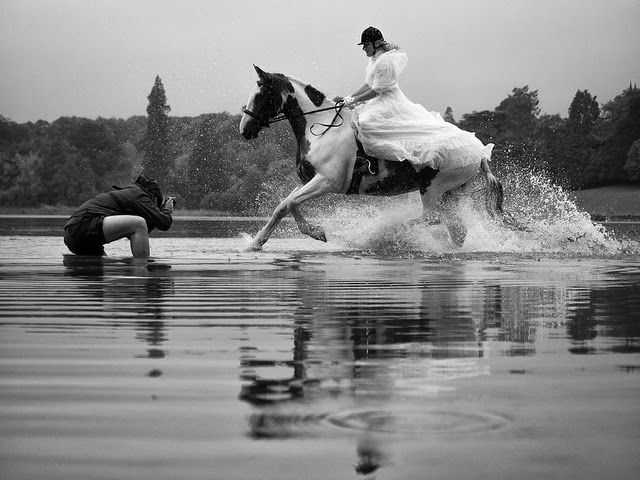I've been looking back through the last several articles I've written and noticed a number of posts about characterization. That's probably because I'm starting a new book.
I love this part of writing--word building, character development--where one gets to dream. This is the staring at a blank wall phase where, if non-writers (in other words, normal people) are around, they give me a concerned look and ask: Is anything wrong?
In reality I haven't been staring at a blank wall, I've been enjoying my very own holodeck.
It's been difficult--almost impossible--to tear myself away from the holodeck and do anything as practical as writing a blog post so I thought I would turn disadvantage into advantage and blog about what I'm doing at the moment; namely, story creation.
Please keep in mind that what I say in the following works for me but your mileage will likely vary. This isn't a one-size-fits-all kind of thing.
How To Excavate A Story
1. The Idea
Think of this as a writer's meditation.
One of the wonderful things about being a writer is that you get to daydream (at least occasionally) as part of your job. Not for the whole day (though I've done that!), or even a significant portion of it, but I think there's no better way of letting an idea catch you.
And really, being honest, I'd say that ideas choose me rather than the other way around. Think about how we talk when we get an idea. I say things like, "It popped into my head" or "Something just came to me."
Fortunately, ideas often come to us while we're doing other activities--taking a shower, going for a drive, weeding the garden, walking to the store. Even when I'm writing another story, ideas will pop in and demand immediate attention.
Come to think of it, ideas are a lot like newborns.
I copy these ideas down in my writing journal and then, after I'm finished with whatever I'm working on, I come back to the ones that have grown roots and taken hold; the ones that demand I flesh them out and bring them into the world.
Okay. So. We've gotten our idea, it's demanding to be developed, let's continue to the next step: stitching the ideas together or, to put it another way, connecting the bones.
2. Fashioning a story skeleton
In the past, this step--cobbling together ideas (/bones) into a story (/skeleton)--was agonizing for me.
It used to be that when I reached this point--I'd have a story idea as well as a small group of related notions that fit together--I'd dive in and start writing. I'd think: Why not? I know who the protagonist is and I have the inciting incident, why not start writing and see where the story takes me?
And you know what? That's fine! It's how many, many, pantsers write and it works for one of my favorite authors, Stephen King.
We're all different and, generally, I don't think we know when we start this journey whether we're a pantser or a plotter. Sure, we may think we know, but we don't really know until we've completed a few stories. (Also, each story is different. Sometimes I can pants a story, but for me that's the exception not the rule.)
I've found, through bitter experience, that pantsing isn't the best--the timeliest--method for me. When I pants I generally end up doing twice as many drafts and have to (and this can be VERY painful) get rid of great chunks of writing when it doesn't serve the needs of the story.
SO I've added this second step which is, basically, putting the bones (the ideas) together so they form a skeleton, one that I hope will hold together through (most of) the many drafts the story goes through.
The problem is that, at this stage, I generally don't have a clue how to get from one idea to the next. In a sense I've got bones but no connective tissue. The bones aren't strung together, they're just lying on the floor in a heap. I have to figure out which ones go together and in what order.
For me, here's the key: I search for patterns.
Something that I've found helps with this is thinking about the universal themes embedded in other stories.
For instance, head on over to tvtropes.org and pick any trope and start reading. I think the basic, essential, structure for every story variation has been recorded on that site. Even if I don't end up using anything straight from there it's a great way to make connections and find missing elements in a story you've mostly uncovered.
Outlines = Roadmaps
Outlines are like roadmaps, they're suggestions. Possible routes. You can always decide to take another route to your destination or, even, to change destinations. Having a roadmap just lets you keep better track of where you are, where you've been, and we're you're going. (That said, one hopes that the fundamental route won't change too much.)
The Excavation Metaphor
I used to believe being a plotter meant I couldn't view stories the way Stephen King does, as preexisting entities--think dinosaur bones--in the soil waiting to be dug up. This is Stephen King's excavation metaphor. He sees himself as discovering stories rather than creating them.
But I think plotters can view stories this way. Rather than doing the excavating while we write we do it while we plot.
The next step is buckling down and doing the writing. And that means deciding on secondary arcs, ushering in helping characters, minions for the antagonist, and so on.
But I've reached the end of this (rather long) post.
What are you working on? What is your method?
As always, good writing!
Photo credit: "Testing the E-M1" by Thomas Leuthard under Creative Commons Attribution 2.0.

